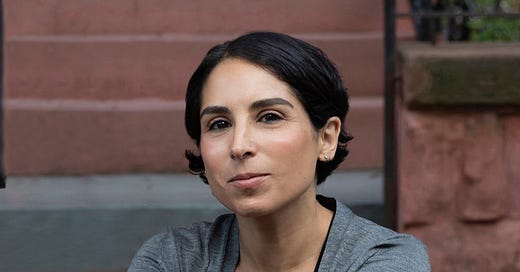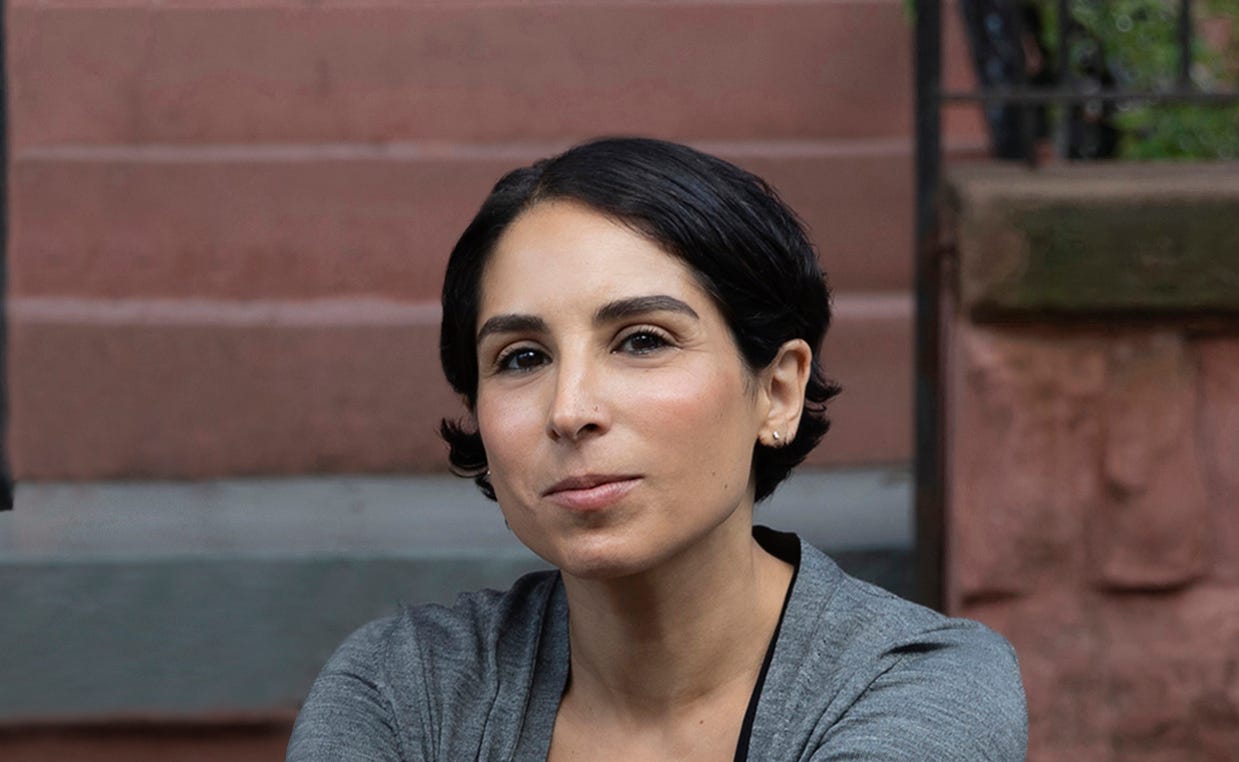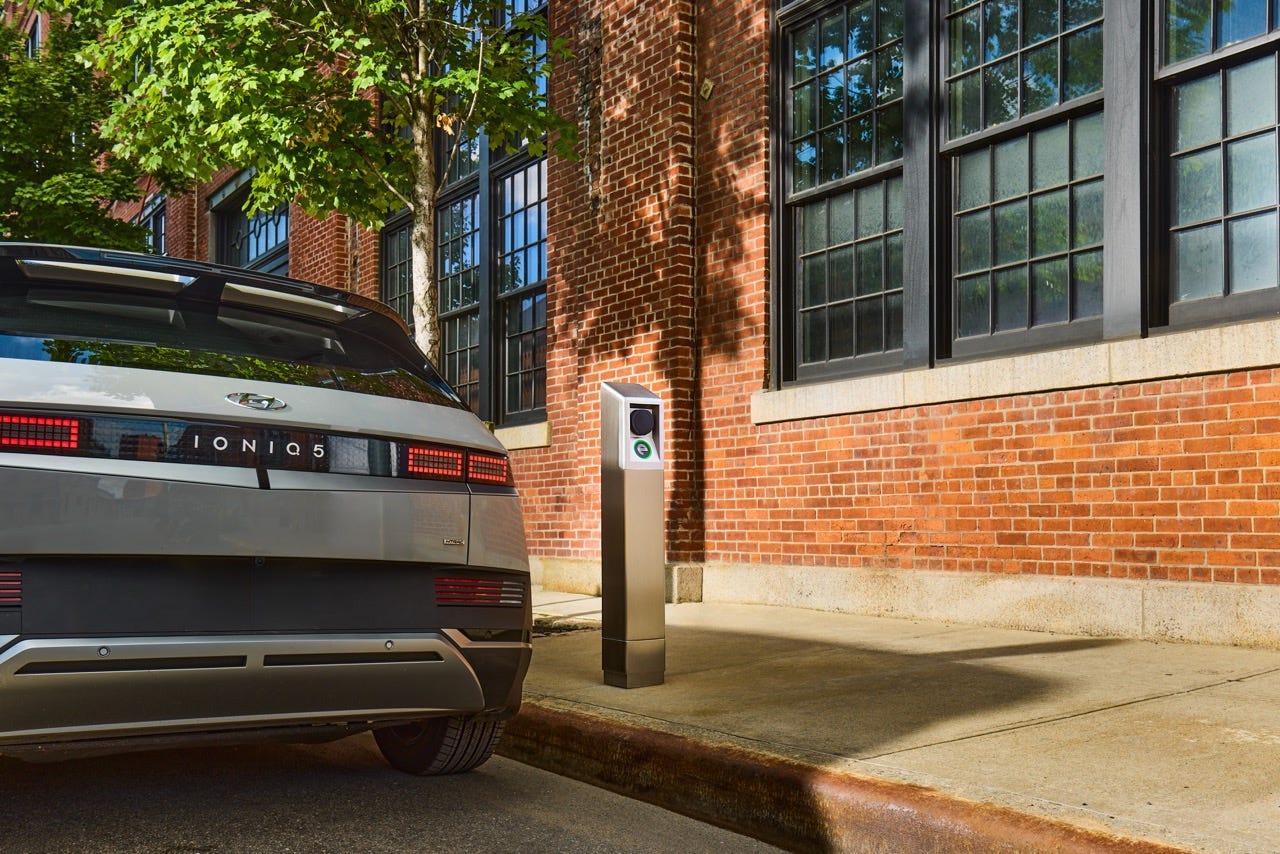Access to charging is a barrier to EV adoption for folks without a driveway or a garage, but what if charging your car in an urban area was as easy as charging your phone? Enter startup Itselectric, which has developed curbside level-2 chargers that connect to building electric panels, making installation quick and efficient. In this episode, co-founder and COO Tiya Gordon discusses the company’s award-winning charger design and vision for a future of ubiquitous urban charging.
Text transcript
David Roberts
Sharp-eyed subscribers may have noticed that I’ve been covering EV charging quite a bit lately — specifically, EV charging for people who don’t have a driveway or garage of their own. I talked to Gabe Klein, who’s running a joint government program exploring charging alternatives. And I talked to Tobias Lescht of Revel, who’s installing level-3 fast chargers in urban and suburban areas.
Why all this attention to charging for urbanites and people living in multifamily dwellings? Partly it’s just a personal obsession, but I also think (and survey data supports this) that worries about charging are one of the key things holding back faster EV adoption, especially among urban populations for which EVs would otherwise make complete sense.
In three years, a startup called Itselectric has taken a different idea from theory to prototype to commercial product. The idea is to make level-2 charging as common in urban areas as fire hydrants, so plugging in cars is as easy as plugging in phones. Its chargers connect to the electric panels of adjoining buildings rather than to main electric lines, which makes siting and installation much faster. The company has won all kinds of design awards and government grants and attracted a lot of buzz.
I’m going to talk to co-founder and COO Tiya Gordon about how the company designed its chargers, how customers interact with the chargers, how the chargers interact with buildings and the electricity grid, and what truly ubiquitous urban charging might look like.
With no further ado, Tiya Gordon of Itselectric, welcome to Volts. Thank you so much for coming.
Tiya Gordon
Hi, David. It's so great to be here. Thank you for having me.
David Roberts
So, the model here is, you put a little EV charger on an urban sidewalk, and it's connected to the adjoining building from which it gets its electricity, rather than connected to the main electric line. I have questions about all parts of that, technical questions, economic questions. But you are a design person. That's your specialty. And I'm a sort of like dilettante design geek. Love thinking about it, love talking about it. So let's start there. You approach this thinking, "Let's make charging ubiquitous. Let's put little chargers everywhere." So, the very first questions you confront when you think about that model is, "How do we design them?"
Design questions are paramount here, I think. So, when you approach this, what are the sort of design guidelines, parameters, or principles that guided you here?
Tiya Gordon
Absolutely, and I'm thrilled to be having this conversation with someone who appreciates design and also appreciates level-2. We call ourselves Team Level-2, so maybe we can pull you into that group with us. So, in a nutshell, design matters. And people don't understand how much design matters until it's absent. And the best analogy I can give for that is my own experience in terms of entering the foray of EV charging. My background was in design and technology, public-facing tech. I did not ever think that I would work in electric vehicle infrastructure. What happened was, I was living in New York City.
It was the pandemic. I lived in an apartment, and previously, all safe forms of transportation, public transportation, became unsafe. And so, I had to think about how I would safely transport, at the time, my five-year-old, how I would be able to reach family members who worked in the hospital systems in upstate New York if something terrible happened to them. And so, I looked at getting a car, and this is the first time I ever contemplated such a thing as a Brooklynite. And I made, like, this list, and it was on my desk, and it was written in a Sharpie on a piece of grid paper, and it said, "New?" "Used?" "EV???" And I had to immediately eliminate electric vehicle from my potential options because there was literally, in 2020 in Brooklyn, no place to charge it. And I thought that was probably not the best sort of news, given that we're supposed to be transitioning as an entire country to this new form of clean energy, and I'm in one of the most densely populated cities, and I literally can't find a charger. So I started looking at charging, and literally the first words that came out of my mouth are now on our website.
And I said, "Why are these all so big and bad and ugly?"
David Roberts
You're referring to other level-2 chargers, right? Because the curbside level-2 chargers are not a brand-new thing. There are others around, other companies doing that. There are others installed in places. I mean, they exist.
Tiya Gordon
Yeah. In 2020, though, I mean, like, the FLO chargers that we have now in New York City, there are 100 of those. Those were not yet installed. The only precedent that existed was, like, a very early program that was happening from Seattle City Light, where they were putting chargers through a company called EVSE on utility poles. So there actually wasn't any curbside charging in the US. LA had not yet started to put their FLO chargers onto light posts there. It was just all we saw were these sort of very, pardon, janky solutions that, you know, in my opinion, in both L2 and L3, they all look like gas pumps.
David Roberts
Yeah, they're big and they're kind of gangly. And we'll touch on this later. But they have the cords hanging off them, which is just, there's no way to make that look tidy, especially if it's used frequently. You know what I mean? Like cords flinging everywhere are like an invitation to messiness, theft, and sabotage, and everything else.
Tiya Gordon
Yeah, so if you'll permit me to geek out on the design front with you, there's this term in design called skeuomorphism, and it's one of my favorite things to talk about because it's like, why does the folder on your desktop look like a folder and not like a cookie?
David Roberts
Right.
Tiya Gordon
It looks like a folder because you know that you put stuff in folders.
David Roberts
Right.
Tiya Gordon
And so, why does this first generation of EV chargers look like gas pumps? It's because they want Americans to go like, "I'm gesturing my arm up really high and I'm pulling it away and I'm putting it into my car." They want Americans to feel comfortable with this transaction. But charging an EV is far more akin, as you said in our intro, to charging a phone. It's just you're plugging in a socket.
David Roberts
What did you take from that? The ugliness of existing — the ugliness of the existing available options.
Tiya Gordon
So, I mean, ugliness is one thing. That was your word, by the way. No, no, it was my word.
David Roberts
I think we agree.
Tiya Gordon
Ugliness was one thing, but that's not going to be the be-all, end-all. Designing a good-looking charger isn't going to solve our charging problems. What we needed to do is we needed to get to the root cause of why there wasn't an abundance of charging in cities, in densely populated cities in particular. And my co-founder and I, who I have to give a shout out to: "What's up, Nathan?" He's your biggest fan.
David Roberts
Oh, hi, Nathan.
Tiya Gordon
He and I were looking at this. He's an architect with a background in overseeing really complex construction projects in New York City. And, you know, we basically isolated that it was that utility connection that was like the no-go. Anytime you need to connect to the utility, you're talking about, you know, an 18 to 24-month process in utility connection agreements, construction. And even for level-2, most of these level-2 chargers going out there in the world, whether they were in, you know, behind the fence, on sort of private property or in public areas, were all doing utility connections.
David Roberts
And let's just pause here. Because that seems crazy. Because as you say, hooking into a main electric line in a city is just a big deal. It's a big — there are application processes. It takes days, weeks. And the amount of power you need for a level-2 charger is not that much. You don't need industrial supplies of electricity, like, you know, it's like a clothes dryer, or something equivalently powered. So it's such overkill to have to hook into the main electric line.
Tiya Gordon
Yeah, the technical term of what you're describing is, yeah, it's a BFD. It's exactly right. That, you know, when you live in a building and you're putting a new dryer in, you're not calling ConEd to get permission to do so. That would slow a lot of things down in the city. ConEd would not like that. So why can't we take that same ease that people who live in suburbs or exurbs and are putting that level-2 charger in their garage? Why can't we just run that same model, but make it a public charger? And that's exactly what we're doing.
So, we like to say, cars powered by buildings. We put our small charger on the curb and instead of going 7ft down into the street and making that inner utility connection, we just power it from the spare capacity in the building that's right next to it.
David Roberts
Right. So, it's as though the building were installing its own level-2 charger; it just happens to be located out on the sidewalk.
Tiya Gordon
And we do it all for them, and we're free.
David Roberts
Right. But it is operating equivalently to, like, an appliance in the building in terms of the electric connection. You know, I'm sure you've heard this a million times, but that seems so obvious. That seems like such an obvious thing to do. Do you know why no one did it before?
Tiya Gordon
I like to say that we're not deep tech, we're shallow tech, about four inches, and we're in the early days of our growth. My favorite, least favorite thing that I've heard more than 500 times is, "If it's such a simple idea, someone else would have done it."
David Roberts
Yeah, yeah. We're kind of in that moment in the clean energy transition. I feel like in a lot of different areas where there are still lots of relatively obvious ideas laying around that no one's picked up yet, because it's also, you know, comprehensive and it's so new. It's just like, there's just lots of stuff. No, where no one's looked yet, but we skip past the design too quickly. So let's talk for listeners, describe for listeners. So I'm picturing a Brooklyn street, let's say a row of row houses, a very familiar icon of Brooklyn. And then out in front of one of the row houses is a little charger on the sidewalk next to the curb.
What does it look like?
Tiya Gordon
It's adorable. Our first model is called the Brooklyn-718. And it's about 3ft and change tall and about eight inches wide. So, it's a little silver cylinder that sits on the curbside and it's sort of like the fire hydrant of 2024. We actually partnered with Billings Jackson design, a great industrial design from friends of the company, to help us design this. And we chose them — they're the ones who designed all those really sleek new bus shelters in New York City. Like the nice ones.
David Roberts
Yeah, yeah.
Tiya Gordon
And we chose to work with them because they've already put 4,000 pieces of electrified street furniture in New York and they know how to produce a design that can endure.
David Roberts
So, a little bit more than 3ft tall, a little more than eight inches wide. That's like the size, basically, of a bollard. It looks like a silver bollard.
Tiya Gordon
It does look like a silver bollard, yeah.
David Roberts
You see bollards all over the place in the city. Like, it's very unobtrusive, I would say, visually. But I guess listeners are no doubt wondering now, if it's just 3ft and it's just a bollard, how do you plug in? What's the interface like?
Tiya Gordon
Exactly. So, what's absent is the cable.
David Roberts
Right.
Tiya Gordon
It is literally just a socket and a little invisible RFID. This is also really important in terms of simplicity of the design. We didn't want anything that was going to face NIMBYism where people didn't want advertising on their blocks.
David Roberts
Right, right.
Tiya Gordon
They didn't want things that were just sort of, you know, we thought about the cities that we love. We thought about the blocks that we love.
David Roberts
Right.
Tiya Gordon
And we wanted to design something that just blended in. So, we are the only company in the United States to offer what's known as a detachable cable solution, or BYOC.
David Roberts
"Bring your own cable," just for people who are not in the lingo. Right. So, there's no cables hanging off the charger. You bring your cable, you plug your cable into your car and into the bollard. So, where do drivers get cables?
Tiya Gordon
Yeah, so I like to say, "You know, bring your own cable. Not weird, just European." And we give you the cable. In the EU, UK, Nordics, the cable comes in the car. So even if you buy a Polestar here, the cable comes in the car. Right now, in the US, the only cable that comes in that car is that level-1 trickle cable that you can use for your garage.
David Roberts
I was going to say, I feel like I got a cable in my Bolt, but it wasn't a level-2.
Tiya Gordon
No, you got it. You got an L1. Exactly.
David Roberts
So, US OEMs are not yet including level-2 cables as standard in their cars.
Tiya Gordon
Not yet, but Rivian just moved the position of their charge port to accommodate curbside.
David Roberts
Hey! So, right now, getting back to the interface with the charger, there's no touchscreen, there's no knobs, there's no real interface. It's just your phone knows it's there and interacts via an app on your phone. Right?
Tiya Gordon
Yeah, the ideal scenario is you park and you charge. You're charging where you already park at night. There's a whole side of the conversation we have to have, going back to level-2, about how extended overnight charging is the most scalable and the most sustainable solution for charging in this country. And I have a million — we can sub this whole conversation just like an L2, L3 lightning round together, which would be very satisfying. But the user experience is you drive back from wherever you are, you park your car within a quarter mile of your building, which is usually what you get in a city like New York, Boston, Orlando, Philly, or DC.
The cable's in the car; it's super lightweight. You take it out, you plug it into your car, you plug it into the socket, and then you either activate the charger on your phone or you have an RFID card and you just tap and you walk away. We're literally trying to take everything that was grody and annoying and frustrating. I'm kind of fresh off the energy of the speeches from the DNC this week, and for lack of a better term, like, it's electric and the name and the brand and what we represent. We want to be like the sunshine and we want to be like the disco that EV charging so badly needs right now.
David Roberts
Yeah, a little flash, a little ease, a little, you know, like the iPhone replaced all those clunky smartphone interfaces. So, if I have the Itselectric app already installed, the charger is going to know me just from me being near to it, so I don't have to —
Tiya Gordon
It's honestly, like, also from my background in tech, it's even dumber than that. You favorite your favorite chargers, you have it ready to go. You open up the app, your favorite charger is already the one that's, you know, because you're never going to get necessarily the same charger, two chargers in a row. It depends. This is public charging. This is on-street charging, right. This is a brave new world that we're entering, but it's one that we just need chargers everywhere. We need to be able to find that charger and park, and these are going to be just —
The next question that naturally happens is, how do we enforce? How do we make sure these spots are dedicated for EV charging? The good news is that cities like New York, LA, DC, and Boston are already making sure that wherever there's a public charger on the curbside, that's a dedicated EV charging spot.
David Roberts
I have questions about that later when we talk about how you interact with the buildings and what the arrangement with the buildings is. But just one last question about the chargers itself. There's no interface. There's no touchscreen. There's no knobs. There's no moving parts. So there's nothing. I mean, I don't want to say, like, sabotage or vandalism is completely not a problem. I'm sure the residents of New York City will figure something out, but there's not that much that can be done to these, right? I mean, there's just not a lot that you can break on them.
Have you had any problems at all with vandalism?
Tiya Gordon
The worst thing that's happened is someone put a sticker on it.
David Roberts
I'm sure they'll all be covered with stickers before too long.
Tiya Gordon
No, no, but wait for it. The sticker was a custom sticker that someone made about EV charging etiquette.
David Roberts
That's hilarious.
Tiya Gordon
Yeah, I mean, this is when we were piloting in New York City, and someone wanted to make sure that people weren't just, like, camping out there for days.
David Roberts
Yes. Yes, that's an issue. So, one more thing about the cables, though. Your long-term business plan is assuming, I think, that everybody's going to have their own cable eventually. But right now, when people sign up for the app, you mail them a cable. That strikes me as not an insignificant expense. Like, how bad is that? And how big of a difference will it make when things become more?
Tiya Gordon
No, it's actually not. I mean, there are two sides of it right now. You know, as easy as you can. You know, people Uber Eats a salad every day. I can get you a cable. It's last-mile delivery in cities. We're really excited. We're working with a lot of different partners on this. We're looking with, you know, three wheels, two wheels. It's very easy to get these cables out into people's hands. They also come in our very stylish tote bag.
David Roberts
Are the cables themselves — I mean, they're pretty simple, right? I mean, they're pretty cheap.
Tiya Gordon
Super simple, super cheap. Super lightweight. Right now, again, these are an existing product. They're all just black. That is the standard market that happens overseas. But there's also this world where we're going to be making some of our own cables. People will get to choose the blue one or the pink one.
David Roberts
Oh, fancy. Customized.
Tiya Gordon
The Volts one.
David Roberts
Yes, Volts-branded cables. Finally. I'll finally get into merch.
Tiya Gordon
Exactly.
David Roberts
You mentioned three-wheelers and two-wheelers and such. Could these theoretically be used to charge your e-bike or your three-wheeler or whatever future weird configuration of EVs we get?
Tiya Gordon
Very easily. Yeah, we're doing some installations here in New York to support sort of three-wheel fleets in specific conditions. You know, people that are sort of basically doing, like, landscaping and grounds work. It's a very flexible opportunity. It's not just for four wheels. Like, it's very flexible. And we're designing it to be able to expand even more so if needed. But right now, you know, it's a standard L2 port, and that covers all our bases.
David Roberts
Yeah, like, do e-bikes use level-two charging? Like, can you just plug a level-two cable into an e-bike?
Tiya Gordon
Is that a side tangent? Like, you know, e-bikes are, you know, the battery swapping model is the better solution for e-bikes. So there are amazing companies like Popwheels that are doing pilots here in New York City, and they're being sort of the models that are already successful in Asia to the US. So, yeah, we could charge an e-bike. We could charge an electric wheelchair. But right now, we're really focused on, like, three main cohorts of transportation. That's private vehicle drivers, that's rideshare — very important to underscore rideshare — and then also fleets.
David Roberts
Right, right. Well, let's talk about site selection, then. So, what does it take for a building to qualify here? Like, how much, what are the sort of tests or metrics that you use when you assess whether a building can get a charger in front of it? I mean, if I'm thinking of this, like, installing a clothes dryer, I can't imagine a building that couldn't handle a clothes dryer. So, is this... I mean, can all buildings do this, or are there any that are off limits to you for some reason or another?
Tiya Gordon
I mean, most buildings have that spare capacity. Our first pilot site in New York City was an old credit union building from the 1980s. The last time that panel was upgraded was probably in the nineties. And we powered it, three chargers off of it without a problem. We ran that pilot for about a year, and that was in Sunset Park, Brooklyn. What we do is buildings sign up. We have a waitlist on our website, itselectric.us. And then there's a button.
David Roberts
So the buildings come to you?
Tiya Gordon
Right now, they come to us. Right now, we just announced our newest city last week, Alameda, California. Within literally like 72 hours of the announcement, we had over 100 buildings signed up. It's really that if you build it, they will come. People want to be able to charge on their blocks. They do not — I like to say, I don't want to have to spend 6 hours in a Walmart parking lot, and neither should you.
David Roberts
Well, I totally get why drivers love this. It's what the buildings get out of it that I want to hone in on. So, you hook into the building's electrical panel and then basically just put an extension cord out underneath the sidewalk, coming up into your charger. So, how does paying work? Because you're consuming some of the building's electricity. How does the payment work?
Tiya Gordon
Yeah, the abstract that you described is absolutely correct, but the nuance is that we put a sub-meter on that building's wall so that any electricity used by the charger is separately metered and paid, so the building's core, your electricity bill, never goes up.
David Roberts
So, the sub-meter is like a separate bill.
Tiya Gordon
That we pay directly.
David Roberts
Got it. So the building, if they sign up and you choose them, you come in and install the charger, which sounds very simple. That takes, what?
Tiya Gordon
Two days?
David Roberts
Two days. Wild that anything infrastructural happens in two days. And then you put the sub-meter in, you pay for the electricity you take out of the sub-meter. So, it sounds like from the building's perspective, they don't have to really mess with anything. They don't have to be involved in this basically at all.
Tiya Gordon
No, I mean, this was like, we also, when we were going back to, like, the early days and the discovery of "what is going wrong with EV charging," we discovered that buildings and cities didn't want to do this because of the pain and the cost. So, we wanted to take that out of the equation and most importantly, I need to underscore that we rev share with the buildings.
David Roberts
Yes, this is the key next thing. So, you're making money from customers. Customers are paying presumably more than what the electricity costs, right? So, there's some profit and you split that profit with the building.
Tiya Gordon
Correct. Exactly.
David Roberts
Is there a ratio or is there a particular contract?
Tiya Gordon
Right now, we've been doing just a flat 20% with all of our buildings. So, let's say you've got like a one or two-family house in Corona, Queens, and you have one charger in front of it, and that one charger is being utilized, you know, 55% of the week, that building is earning more than enough to pay its annual electric bill.
David Roberts
Wait, they're earning enough from the charger to pay their non charger related electricity bill?
Tiya Gordon
Correct. Their core residential utility bill.
David Roberts
I see. So, they're making money without having to do anything more or less is what it comes down to. I guess it's pretty clear why they sign up then. The only question I had, the only, as I was thinking about this, like, why wouldn't a building want to do this? The one thing I come back to is street parking is pretty precious in cities, especially in dense areas of cities. So, when a building signs up with you and puts one of these in place, who controls the parking space, I guess is the question?
Tiya Gordon
Good question. And to be clear, we first need that city's permission before we can go into that city and work with building owners.
David Roberts
But, I guess, why? I guess you're messing with sidewalks.
Tiya Gordon
Because we need to get a permit for the sidewalk. So, we need the cities to be on board with this and the big shift, just in terms of curbside charging —
David Roberts
You need the cities to be on a general level. Do you need the city to approve each one?
Tiya Gordon
It depends. What you need to do is you need to do something called a "revocable consent" or a "revocable permit." And in a lot of situations, you can basically rubber-stamp that. You can kind of file that permit and then add the addresses to it over time.
David Roberts
I see.
Tiya Gordon
And this way, you're not having to go back and expedite permit after permit after permit. But even with that step of having to permit each site, we still take care of all of that because the cost and the headache — we had, actually, a potential customer reach out to us to say, "Yeah, yeah, I'm in New York, I have a building, I want this. I don't want to wait for everyone else to do this. I want this now, how much would it cost?" and we did the research of what expediting that one permit would be. It was about $35,000.
And they're like, "Okay, I'll wait." There's a story of a couple in Virginia that did this and they paid $70,000.
David Roberts
Good Lord.
Tiya Gordon
Yes.
David Roberts
But if the city agrees, then you don't have to pay for the permit, basically? Do you have to pay for the permit if the system is all set up?
Tiya Gordon
The way that we try and work it with cities is that, given that we're coming in and we're offering a lot of our services and our product without cost, they're waiving the permitting fees.
David Roberts
So they've been waived in the cities you've operated in thus far?
Tiya Gordon
Everyone is different, but more or less, that's what we're angling towards.
David Roberts
I mean, it does seem like the city is getting quite a bit of value out of this for no real cost.
Tiya Gordon
Yeah, we're excited. I mean, it's gone from us basically cold calling cities two years ago saying, "Have you heard of this thing called curbside charging?" To now, like, responding to inbound RFPs every two weeks or so.
David Roberts
Well, before we move on from the parking space, what if I'm a building owner and I want to say, "I'll make this spot available for public charging for 12 hours a day, but then the other 12 hours, I want my car parked." The building owner wants his car parked there. Is that a thing that they can do, or do they have to basically agree, "We're not going to put any restrictions on this parking space. Whoever comes can plug in."
Tiya Gordon
They can't put any restrictions on the parking space any more than they can today without that charger there.
David Roberts
That's true. It is public parking. So —
Tiya Gordon
Yeah, but I mean, just putting it out there, until adoption ticks up, if you have an EV, you can basically get yourself a parking spot a few days a week if you're charging.
David Roberts
Right. Right. So, then how do you prevent people from just using these spaces as spaces?
Tiya Gordon
Yeah, it's the cities that do that. So, in New York City, there's a local law already on the books where it's a loading zone violation if you park in front of a dedicated EV charging spot.
David Roberts
Do they enforce that? Because there's this whole angst about it in New York, especially parking in bike lanes, parking on curbs. It's a madhouse. So, you actually are at some risk if you try to park in one of these things.
Tiya Gordon
The peril being, if you're not an electric vehicle and you're parked in this spot, you get a ticket. That's the consequence.
David Roberts
What if you're an electric vehicle and you're parked in the spot and you're not charging?
Tiya Gordon
EV drivers are not really trying to mess with each other like that.
David Roberts
Well, I mean, I'm just saying parking is valuable in and of itself, whether there's a charger there or not. You know, people might just want a place to park.
Tiya Gordon
Yes, there will be, perhaps, a world in which there can be loitering fees and other ways to motivate people to circulate out of the spot. We've seen very good etiquette from drivers where we've started to put these posts out into the world.
David Roberts
The other thing that you see a lot, and you see this a lot with level-3 chargers, is just a frequent complaint: somebody's plugged in, they're already full, but they're off getting a coffee or whatever and taking up the space. Is there any formal way of discouraging that, or are you just relying on good manners?
Tiya Gordon
Oh, that is a problem. I've been there at a parking lot at 11:00 at night with 2% battery, and someone's just chilling at 95%. The issue there is just, again, it goes down to, I believe, quantity of chargers. The tension is such because there's such limited resources that it creates this sort of social anxiety. But when we have more chargers, I truly believe that will not be an issue.
David Roberts
Well, this gets to a great question that I wanted to ask about, which is, it seems like one of the things you need to be worried about is balancing supply and demand. If there's a single charger on a block and ten people on the block sign up for the app, then you've got ten people basically competing over a single charger. So, are you cognizant of sort of, like, only allowing enough people to sign up to sort of keep in some balance with the number of chargers available?
Tiya Gordon
It's a great question. I mean, we're in this brave new world where we're putting in this new form of infrastructure that never previously existed.
David Roberts
Yeah.
Tiya Gordon
And so, a lot of cities are doing, like, "Let's try it, and let's see what happens." So, Boston, where we're deploying right now, Mayor Wu, has the target of having a public charger within a five-minute walk of every Bostonian. Right. But we're going to start with a couple of hundred, right.
David Roberts
Right. I guess my question is, how do you keep those couple of hundred from just getting swarmed?
Tiya Gordon
That's the best possible thing that can happen, because when they are swarmed, we can demonstrate the demand.
David Roberts
Right.
Tiya Gordon
We can curate the location of these chargers within the actual lot that signs up for us. That's the beauty of what we're doing here, is that when you are making utility connections, they have to tell you where those connections can be made. You just can't put chargers anywhere, whereas we can literally put them anywhere where there's a building and a curb. So, if we see demand go really hot and really light up in one particular area, we can quadruple chargers in that area and not have to go through any barriers in terms of coordination with utility.
David Roberts
So, boosting supply to meet demand is relatively easy for you. You can move pretty quickly. And so, you don't — I meant to ask about this before when we talked about permitting — you need a permit to go into the sidewalk, but you don't have to mess with the utility at all.
Tiya Gordon
Nope.
David Roberts
Like, you don't have to... There's no utility involvement in any of this. What a blessing. I mean, no offense. Wait. Yes, yes, offense to utilities. You don't have to contact them or get them involved in any way?
Tiya Gordon
I like to say that even though we don't rely on utilities, we want to make sure that they're aware of us. So, you know, we have letters of support from a large number of utilities in this country we're working on, with certain utilities on both coasts, on pilots that are very, very specific, that utilize our behind-the-meter approach to put charging where otherwise it would be a very low priority for them to get charging, and we can get there faster. And the reason why utilities like us is because we are helping them offload that overnight inventory. Going back to our level-2, L2 can do that slower overnight charge, and we can help with the balancing of demand by pushing more people to that overnight charging. Utilities are happy because I don't know about you, but I get alerts from ConEd on my phone every summer, especially this summer, telling me to reduce my energy consumption because it's 95 degrees out. So I'm sure you've gone there already in your head, but when you have an uptick in adoption, we cannot have 700 New Yorkers do a fast charge on a Saturday in July.
David Roberts
Yes, yes.
Tiya Gordon
Megawatts of power that are unaccounted for right now.
David Roberts
Yes, so level-2 is just, I mean, even if you had ten of these on a block and they were all in use simultaneously, would that still not be enough power to basically be any kind of threat or problem?
Tiya Gordon
No, I mean, there's easily, you know, on an average city block, 60 buildings, three units per building. So, you're looking at, you know, let's assume that one out of those three has an electric dryer.
David Roberts
Right.
Tiya Gordon
That's the level of load that we're talking about.
David Roberts
Right. But just to clear that up. So, permitting wise, you get a permit to go into the sidewalk. Otherwise, you're only dealing with the building owner, basically. There's no — you're bypassing all sorts of permitting bureaucracy.
Tiya Gordon
Yeah, we get a basic electrical permit for the building, the same as if you were putting in a new kitchen, which takes less — electricians can pull that the same day.
David Roberts
Right, right. Interesting. So, one of the things I was going to ask is whether the chargers themselves have any intelligence built in such that they're communicating with the grid, such that they can shift demand around and all that kind of stuff. But it occurs to me when you're talking level-3, to get back to the level-2. Level-3, when you're talking about level-3, you need that because you're talking about such massive quantities of power happening. But maybe in level-2, you just don't need it. It just doesn't matter. Do you have any of that stuff built into your charger?
Tiya Gordon
Yeah, our backend has load management. So, we can easily turn up and down in terms of demand. We just want to make sure that the driver wakes up with a full battery. If more of the charge happens earlier versus later in the evening, those are the things that we can start to control.
David Roberts
So you do have some control then, over the shape of the demand curve coming from your chargers?
Tiya Gordon
Yeah, and we also participate with different utilities in sharing data with them to help anticipate, help project, and help find ways that we can scale charging in a very sustainable way. Level-2, overnight is just the path of least resistance. It's right in front of us. It's available to us now.
David Roberts
Yeah, but do you participate in any demand response programs or anything like that?
Tiya Gordon
We are working right now on advancing an application we have for the first urban vehicle-to-grid for curbside.
David Roberts
Oh, feeding power back from the cars into the grid via your chargers.
Tiya Gordon
Exactly. So, think about how when we have brownouts. Right. You know, cars are just moving batteries.
David Roberts
Yeah.
Tiya Gordon
And you just be able to push that back in, and then provide that incentive to the driver for pushing their energy back into it.
David Roberts
Well, geez. If you had these ubiquitous in an urban area, and they're able to either power cars or take power from cars, that's a whole different thing. That's a bigger thing. Then, you're talking about a very, very large virtual power plant.
Tiya Gordon
And then, the cherry on top is you look at cities like New York with Local Law 97, where we're putting solar on rooftops. And then, you get this closed loop system.
David Roberts
Right. The panels are talking to the chargers, and they're talking to the grid. And the whole thing's coordinating. That's right. That's our beautiful future. Is that vehicle to grid? Is that technologically, are you there yet?
Tiya Gordon
That's on our roadmap. We are working on that. We're working on getting some funding from the state right now to explore that opportunity.
David Roberts
You've gotten a couple of awards from various — with the fire hose of infrastructure and IRA money going out. I've completely lost track of the names of all these programs that are hosing money out. But you've gotten money from a couple of them, haven't you?
Tiya Gordon
Yeah, I mean, we wouldn't be where we are today if it weren't for groups like the Joint Office of Energy Transportation. I know that you've had Gabe Klein on the podcast.
David Roberts
Yeah, yeah. I meant to mention, when I mentioned Gabe Klein, that you are one of the experiments that his office is helping to fund.
Tiya Gordon
Yeah, and it's people like Gabe that have this vision for the intersection of government, private entities, startups, and energy. Also, the fact that, you know, like, Gabe likes to ride an e-bike. I think that this is: This might be an unpopular opinion for some, but, like, I don't have a car. I have a bike. And even today, I had a meeting in the city, and I'm calling you in from Brooklyn, New York, where we're headquartered. So I got on my electric city bike to get back in from the city.
And something happened that never happened before: I checked it out, and it had 35 miles on it, and I was like, "This is crazy." Like, where would I even go? Just, like, if I canceled all my calls today and just kind of took this e-bike for its full maximum value. And it made me really kind of think about how EVs are, in many ways, literally the perfect car for cities. If you are a private vehicle driver, you are not putting more than 20 or 30 miles a week on your car.
David Roberts
Yes.
Tiya Gordon
And so, if we have smaller cars, smaller batteries, and we're just kind of, like, running these loops around cities, which is what we do, and we can charge them very conveniently where we live. It's almost by design, if you will.
David Roberts
Yeah, it's like a perfect closed loop. So, what are you doing with fleets? What types of deals are you trying to strike with fleets? Like, you have a deal with Uber, do you not?
Tiya Gordon
So, we're working with Uber. We're really excited about this partnership because not only does Uber want to be all-electric by 2030, but they're really pushing that from the perspective of a private entity. Right. There's not pressure that's coming on them from the government to do this. They're doing this because they see themselves as a sustainable platform of the future. And where we come in is that Uber drivers, most of them, if you look at a city like New York, they don't live in Midtown Manhattan, where the chargers are. Yeah, they live in Jackson Heights. They live in Flatbush.
And there's something also on top of that where there are some actual local laws now in New York City. So, we have something called the Green Rides Initiative that requires rideshare to be electric by 2030. And that's also in California as well.
David Roberts
Yeah, I was going to say, this is not all Uber being kind-hearted. There are regulations in the wings.
Tiya Gordon
Well, they're doing it across North America, and then it's New York and California that have their own policies. But what we're doing is, we've identified, you know, it was very validating to have those early conversations with Uber because, you know, here we are, a small, very small startup here in Brooklyn, and then you have a group like Uber, and you're, like, nodding your head, finishing each other's sentences about how it's really difficult to charge in cities. And wouldn't it be great if we could just put curbside charging in the neighborhoods wherever their rideshare drivers park at night because they're currently losing wages in the time that it's taking them to drive to fast chargers at, I'm not joking, JFK airport. I don't know about you.
David Roberts
Well, you know, I had Revel on a few weeks ago, and they are trying to solve this problem by putting more level-3 chargers in those neighborhoods. I take it that — do you think there's room for level-2 and level-3 in the infrastructure?
Tiya Gordon
We need both, right? Yeah, we absolutely need level-2 and level-3. I mean, statistically, NREL DOE wants 1 million L2s and they want 160,000 L3s. Right? Like, we want more L2s. We want them everywhere. I like to talk about this quote all the time, Kim Stanley Robinson from Ministry from the Future, he has this concept, and he talks about, like, apocalyptic climate results occur when you have abundance versus adequacy, and that's what I constantly frame, L2 versus L3. I don't need to do a level-3 charge for my day-to-day work here in New York City. If I'm going on a road trip, if I'm going cross states, absolutely.
David Roberts
Right.
Tiya Gordon
But a four-stall fast charger uses as much energy in a month as a 300-unit apartment building. So again, ConEd alerts on my phone, "Stop using energy, Tiya."
David Roberts
Yeah.
Tiya Gordon
L3 charging.
David Roberts
And just dealing with utility, dealing with a lot more permitting and siting issues and all that stuff. So, what is the deal with Uber, though? Like, are they, I mean, I see from their point of view why they're excited all of a sudden. You know, why they're excited that a bunch of L2 chargers are going to be springing up in the neighborhoods where their drivers live. What are they doing for you?
Tiya Gordon
Yeah. So, they actually came in, we just raised a round of investment, and they came in and they helped to lead that round. And the round was co-led also by a great group called Failup, which is a Nordic fund. And it was the funniest conversation when we met them, because we're like, "Hey, this is what we're doing. We're doing this in New York." And they're, of course, from Finland and they live in Helsinki, and they're like, "Of course you need charging everywhere. You're telling me that you don't have this?
David Roberts
Yes, yes. It is a pretty obvious need. Am I right in assuming that in a place like Norway or whatever, or maybe most European countries, that curbside charging is already everywhere and ubiquitous? Like this, none of this would surprise a European at all?
Tiya Gordon
No, no. My summer vacation has been made up of me sitting in my office, working very long hours, and people texting me photos of curbside chargers from across Europe.
David Roberts
While you slave away in Brooklyn, what about fleets? Are you trying to specifically strike deals or do offers with fleets, or are fleets permitted to use your chargers? Do they have to do any special deal with you? How do you interact with fleets?
Tiya Gordon
Yeah, I mean, fleets are private, they're public. Right now, the way that we're interfacing our earliest arrangements with fleets is through city agencies that have fleets, where often those drivers take their car home at night, they're not being left in a depot. So that's a very obvious case for us. That's a very clear demonstration of where our technology is a fit. And then there's also sort of larger moves we can do. I can't go into specific detail, but there are companies that manage the payment for fleet transactions. And right now, all of these fleet drivers have a gas card.
David Roberts
Right.
Tiya Gordon
And so, how do you convert a gas card into an EV charging card? So that's, you know, the payment side of it is interesting because, you know, fleet drivers put all their miles on this specific card that then is processed and data is processed, and they do whatever they do in the world of fleet management. And so, yeah, that's also where we're trying to help find our solution, to be able to fit in with what they're doing.
David Roberts
Like, it would be integrated into your app somehow.
Tiya Gordon
Or not even that. Just more like us getting into their platform, them battle testing us, them saying, "You guys check all the boxes and you can be one of our fleet solutions."
David Roberts
Have any of these — I'm sorry, this just popped into my head — but have any of these been hit by cars yet?
Tiya Gordon
Not yet, but —
David Roberts
I'm curious who would win in that encounter?
Tiya Gordon
I'm glad you asked. We actually designed this to be modular, like a Lego. Guess what? It's going to get hit by a garbage truck. Guess what? Someone's going to try and, like, shove gum in there. Like, my background, again, is public-facing tech. I've seen the worst of it. I know that people don't care. And so that's why we, when we actually design them, the unit itself, it's modular. It's like a Lego. So if someone runs into it, destroys it, we don't have to roll out a truck and do diagnostics and figure out what's wrong. We literally just pop it off, and we pop the new one on and click it onto the base and drive away.
David Roberts
How much? I mean, maybe you don't want to tell me this, but, like, how much does that little Lego unit cost? Like, it strikes me that it can't be that it's pretty simple electronics involved here, right? I mean, it can't be that expensive.
Tiya Gordon
It's one-twentieth the cost of what other curbside chargers are.
David Roberts
All right. Well, we're running out of time. But I have two final questions, both of which are slightly vague and speculative. One is, whenever this comes up, whenever EVs come up, EV charging comes up. There is a faction of people in my world who get their dander up a little bit because their whole thing is, "What cities need is fewer cars. What we need to be doing in every city is designing cars out of the picture." And insofar as you put in infrastructure, stable infrastructure like this, that is devoted to cars, you are effectively locking in car use in that area.
So, if there's a bunch of chargers on the street, then that's going to skew the decision about maybe someday turning that street over to pedestrians or... You know what I mean? Or getting rid of cars somehow. How do you think about that tension between locking in cars via infrastructure and the need for a bigger approach to urbanism?
Tiya Gordon
Absolutely. I mean, I'm probably the only person who works in... Actually, maybe there's a few. There's a handful of us. My co-founder and I, we did all these old, like, early 2000 critical mass rides in New York City. You know, we wore t-shirts that said, "One less car." We don't want more. I don't want more vehicles on the road. I want more bikes, less cars. Everything electric. When I'm on my bike, I want to be behind a car and not be breathing in those fumes.
David Roberts
Yeah.
Tiya Gordon
It's naive to say that I'm going to see a car-free city in my lifetime. What we want to do is we want to have more multimodal transportation. We want to have more public transportation, but we still do need vehicles and we want to make those electric. And right now, that's the problem that we're focused on solving: how do we break down the remaining barrier for electrification of transportation in cities? And that's charging.
David Roberts
I'm wondering, though, say a street did pedestrianize around one of your chargers, so there are no more cars. Could it be useful for other stuff?
Tiya Gordon
Oh, yeah. You could totally power a bouncy house off of it. 100%.
David Roberts
Yeah, I guess I'm trying to conceive of, like, that level-2 plug-in. How common is that in non-car applications?
Tiya Gordon
Let's be utopian. Let's do a car-free street. I'm picturing a particular block in my neighborhood in Brooklyn, and let's have that on-street outlet. It could power a food truck. It can power a variety of different public means.
David Roberts
Right. Yeah. Just sort of like electricity infrastructure is useful in and of itself, even separate from the cars.
Tiya Gordon
Yeah.
David Roberts
More plugins are better, I guess, in today's world. Full stop, basically. Okay, well, the final question then is, and this is related to the, like, 'this idea seems obvious'. Why has no one else done it before, is one question? But perhaps even slightly more mysterious, is why are you the only ones doing it now? Like, it seems like it would be very easy for a giant, multinational megacorp to come in and just bigfoot you with its resources and just install more and faster. Where are your competitors?
Tiya Gordon
I don't know. Believe me, there's many a day where I'm looking over my shoulder, you know, anticipating what can happen next. We have a few folks that are over, obviously, already doing this in the EU and the UK. They have an eye on this market. But again, if we need 1 million of these charge ports in the US in six years, we need more companies doing this. Is it all going to be our specific flavor? No, there can be other flavors that are involved here, but we do want socket-based charging to be ubiquitous. It'll be, you know, far more common, far more understood.
However, you know, we're definitely the first ones that are out there and there's always going to be that first mover and that's Itselectric in the US.
David Roberts
I meant to ask first mover where, like, where are you now?
Tiya Gordon
Yeah. So, we did our first pilot in New York City. We just were awarded the city of Boston. We were awarded the city of Alameda.
David Roberts
When you say "awarded," that means you're going to go there.
Tiya Gordon
Yeah. So, contracts are signed, buildings are signing up. So, if any of our listeners are in Boston, Alameda, Los Angeles, San Francisco, Yonkers, Jersey City, Alexandria, we're coming to you. We're coming to... "We like your curbs," as we like to say.
David Roberts
I mean, do you have, are you worried at all about like scaling up fast enough? Like, do you have scale? It just seems like the kind of thing that once cities get wind of it, they're just gonna be like, "duh." Are you worried at all about being swamped? A little bit about being overwhelmed?
Tiya Gordon
I thrive from being swamped, so I'm okay. But that's also why we did just raise a bunch of capital so that we could meet the demand that we see coming towards us.
David Roberts
Interesting. I'm just thinking also about all these types of land use or these areas that aren't quite dense urban, but aren't quite like exurban either. And I wonder, there's lots of single-family residences that have spare electrical capacity as well. Is there any reason — I live in, I guess what you'd call, an inner-ring suburb of Seattle in a single-family home — is there any reason I couldn't put one of these out in front of my house and just let my neighbors use it? Like, is anyone doing that?
Tiya Gordon
No, I mean, again, like once we have that city's permission, we're happy to put chargers where that demand exists. We were surprised by a lot of the sign-ups we got. We thought we were only going to get those from super dense cities. But you forget that so much street parking happens because of conditions between landlord and tenant. You have college students. We get a lot of demand from the hub and spoke of major college areas where there's tons of street parking because of the student rental population. So, there's a case for us to be in less dense neighborhoods than we once projected."
We really thought we were only going to be sort of clustered in the Northeast when we got started, but we're already in Detroit as well, I should mention, and also West Coast.
David Roberts
This is fascinating. Tiya, thank you so much. What a fun time for you here. Like, you know, first mover in such a rich market. I hope you're enjoying yourself.
Tiya Gordon
Thank you, David. It's so nice to talk to you.
David Roberts
Thank you for listening to Volts. It takes a village to make this podcast work. Shout out, especially to my super producer, Kyle McDonald, who makes my guests and I sound smart every week. And it is all supported entirely by listeners like you. So, if you value conversations like this, please consider joining our community of paid subscribers at volts.wtf. Or, leaving a nice review or telling a friend about Volts, or all three. Thanks so much and I'll see you next time.

















Share this post